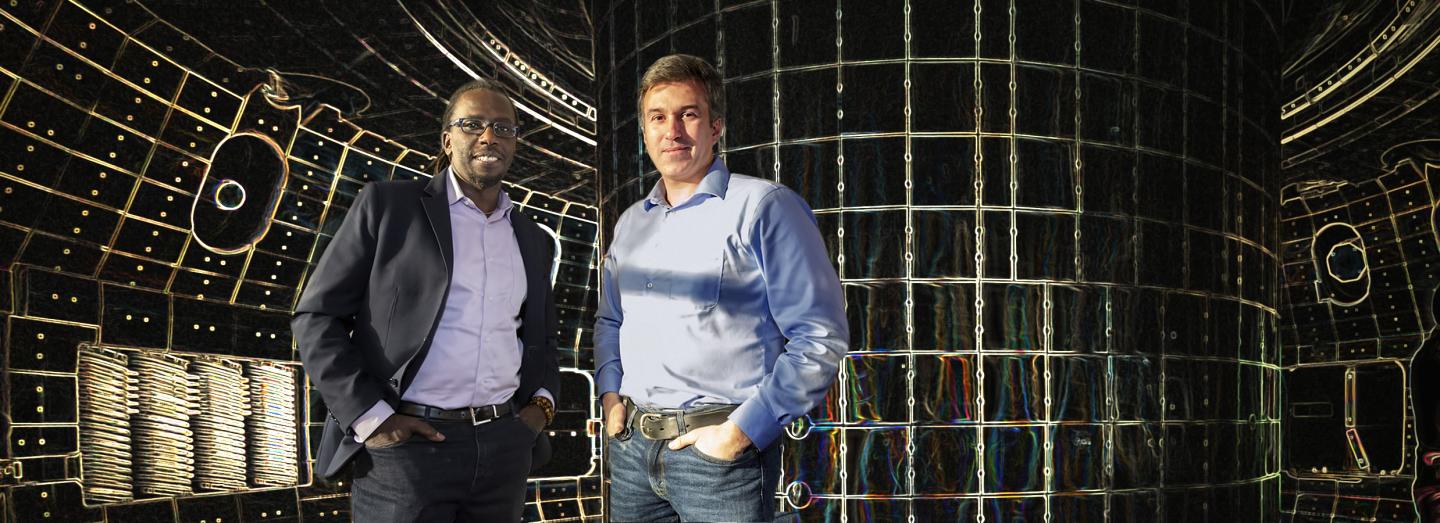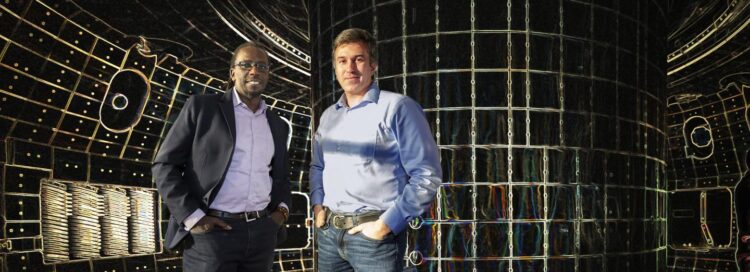
Credit: Photo and collage by Elle Starkman/PPPL Office of Communications.
Picture strong wind blowing against a tree until it’s knocked down. Such action would mimic the process that causes damaging heat bursts called edge localized modes (ELMs) to flare up in fusion facilities called tokamaks, which scientists use to develop on Earth the fusion energy that powers the sun and stars. Such heat bursts normally occur when the pressure at the edge of the hot plasma gas that fuels fusion reactions reaches a peak, causing heat to erupt against the walls of the tokamak, much like a tree finally toppling in a growing wind.
However, researchers at the U.S. Department of Energy’s (DOE) Princeton Plasma Physics Laboratory (PPPL) recently found that the heat bursts sometimes can occur during the recovery from eruptions — providing fresh insight into what triggers the bursts. The findings, based on data collected from past experiments on the DIII-D National Fusion Facility that General Atomics operates for the DOE in San Diego, California, could help tame the potentially damaging processes.
Network of waves
“Piecing the dots together, we found that a network of interacting waves suddenly plays a role in the ELMs process during recovery,” said Julien Dominski, a PPPL physicist and lead author of a paper describing the results in Plasma Physics and Controlled Fusion. “These waves come together and abruptly exchange energy,” Dominski said, “causing the ‘pedestal’ at the edge of the plasma to crash and release bursts of heat.”
This network, which consists of triads of waves, is key to the triggering, Dominski said. “Sometimes the network can be excited without causing the abrupt crash,” he said. “This enabled us to look into the physics governing this new picture.”
The findings grow from efforts to reproduce fusion reactions that combine light elements in the form of plasma — the state of matter composed of free electrons and atomic nuclei that makes up 99 percent of the visible universe — to generate massive amounts of energy in the sun and stars. Tokamaks are the most popular devices that scientists around the world use in experiments to capture and control fusion energy, hoping to create a virtually inexhaustible supply of safe and clean power to generate electricity.
Emerging picture
“The new findings are an emerging picture for the triggering mechanism of ELMs,” said Ahmed Diallo, a PPPL physicist and co-author of the paper. “Discovering this network opens a new chapter in the study of ELMs.”
Coinciding with these networks, the physicists found, are perturbations at the edge of the plasma caused by a device called a neutral beam injector (NBI) that is used to heat and fuel the plasma. The millisecond intervals between NBI perturbations correspond with the intervals between network occurrences, the scientists noticed. “Making this connection was exciting and gave us an insight into a new way to trigger ELMs,” the authors said.
The researchers next aim to conduct experiments to study how triggers for ELMs may vary and test the use of NBI beams to control the bursts. Support for this research comes from the DOE Office of Science.
###
PPPL, on Princeton University’s Forrestal Campus in Plainsboro, N.J., is devoted to creating new knowledge about the physics of plasmas — ultra-hot, charged gases — and to developing practical solutions for the creation of fusion energy. The Laboratory is managed by the University for the U.S. Department of Energy’s Office of Science, which is the single largest supporter of basic research in the physical sciences in the United States and is working to address some of the most pressing challenges of our time. For more information, visit energy.gov/science.
About the DIII-D National Fusion Facility. DIII-D is the largest magnetic fusion research facility in the U.S. and has been the site of numerous pioneering contributions to the development of fusion energy science. DIII-D continues the drive toward practical fusion energy with critical research conducted in collaboration with more than 600 scientists representing over 100 institutions worldwide. For more information, visit www.ga.com/diii-d
Media Contact
John Greenwald
[email protected]
Original Source
https:/
Related Journal Article
http://dx.





